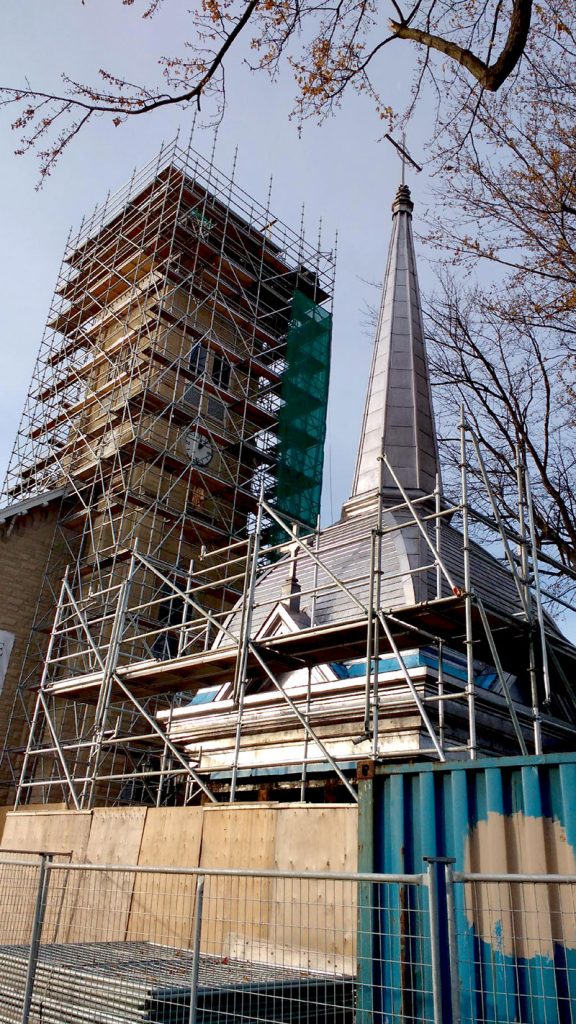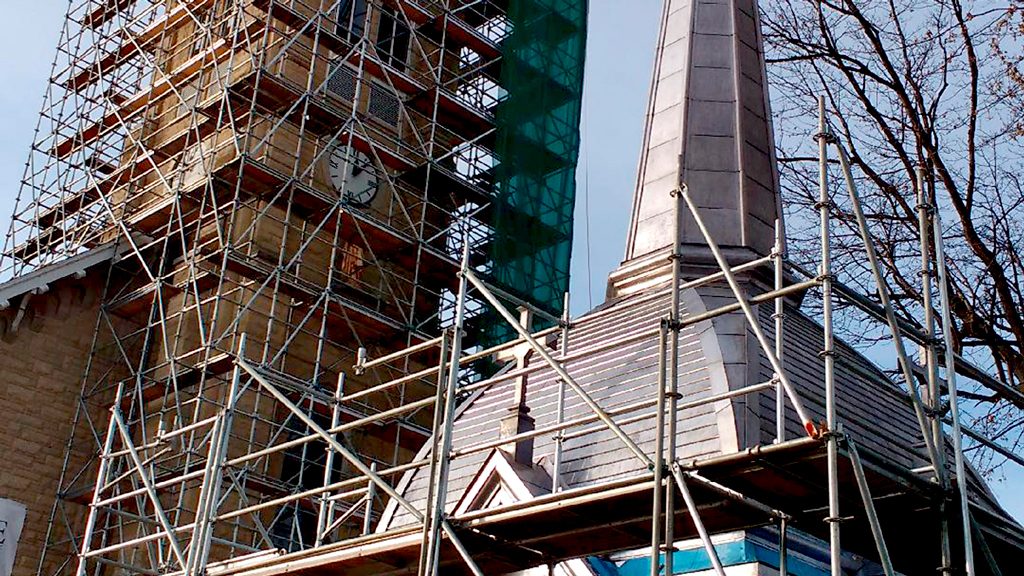Some 200 parishioners of St. Anne parish and residents of the town of Tecumseh in suburban Windsor, Ont., braved the mid-November early morning chill for an unusual and long-anticipated event — the raising of a steeple onto the tower of the more than 100-year-old church.
For safety reasons, the steeple, plagued by deteriorating wood, had to be dismantled and hoisted down to the church’s front yard 10 years ago.
There it has incongruously sat at the corner of the town’s two main streets until the parish could raise funds to rehabilitate it and its base tower, and then to reattach the structures.
After a major benefactor donated $2.5 million last year, a schedule was set to finally rebuild and re-install the 28,000-pound iconic structure, originally home to the area’s French community.
The parish, backed by the Diocese of London, contracted the same company involved with the spire’s takedown, Mississauga’s Roof Tile Management, a specialist in church heritage restoration. Technically Roof Tile was a subcontractor overseen by Windsor’s W.D. Lester Construction.
We basically set up a whole shop out front, in sea shipping containers
— Blair Britton
Roof Tile Management
The wood deterioration was not only within the spire but within the church tower’s support base. Rotted wood had to be stripped and a new 15-square-foot, 12-inch slab poured. Previously, the steeple has rested on 12 wooden legs. They were also replaced by 12 steel columns, each measuring 12 feet in height.
Matching the slab base to the spire — which included a cupula — was the real challenge, according to construction firm president Bill Lester.
“The new steel and concrete slab that are on the roof had to be matched to the new construction that was on the ground, and we had to make sure that the dimensioning was proper so that nothing was out of square, and that the old structure fit perfectly into the new,” he said.
While the top of the 104-foot tower was readied down on the ground, Roof Tile set to work cleaning the internal steeple of rot and adding a new exterior finish. That took seven months. A mini construction site, complete with a workshop, was set up on the church’s front lawn.
“We set up a shop onsite with copper coils and brakes, benches,” said Roof Tile project manager Blair Britton. “We basically set up a whole shop out front, in sea shipping containers.”

The tower’s former sheet metal took two weeks to strip off.
New wooden joists were installed — though some of the original solid wood stayed — then a cover of half-inch plywood sheets, surrounded by a Blueskin WP 200 self-adhering composite membrane. Finally, the copper finish was applied, a job that took four months and was somewhat painstaking, Britton explained.
“It’s very detailed, we had to make all the panels onsite,” he said.
This required measuring using the original pieces to make templates and jigs for the new ones, resulting in creating “hundreds” of new pieces, he said.
The day before the hoist, London’s Cameron Crane & Riggers drove its largest piece of equipment, a 350-tonne Grove Mobile hydraulic crane (GMK6300L), down Hwy. 401, a two-and-a-half-hour drive.
Operator Dave Palsa, of Exeter, was at the controls.
On the morning of the hoist, he had 78,000 pounds of counterweight and extended 226 feet of boom. With a steer-by-wire operation Palsa was confident in positioning the spire properly.
“I can turn my dials down so that I can be as smooth and slow as I want,” he said. “But to tell you the truth, you’ve got to treat every lift like it’s delicate.
“You’ve got to take the precautions, you’ve got to make sure that it’s rigged right. Because the last thing you want to do is destroy this. Everybody had their hopes and dreams up there, you don’t want to destroy it on them.”
The operator said the bottom line was the rigging — the cables and shackles that hooked the steeple.
“If one of those straps would have broken, that’s catastrophic,” he said.
The hoist was an inside job. Inside the steeple was a “box” composed of four saddle clamped crisscrossed I-beams. This box was what the crane hoisted.
“So when we picked up that steeple we picked it up from the base of the steeple,” Palsa said.
The entire lift took about 45 minutes and ended with applause from the 200 onlookers watching from the ground below.
“It was very nice that it was historic and it was very nice that the church was being restored,” Palsa added.











Recent Comments
comments for this post are closed